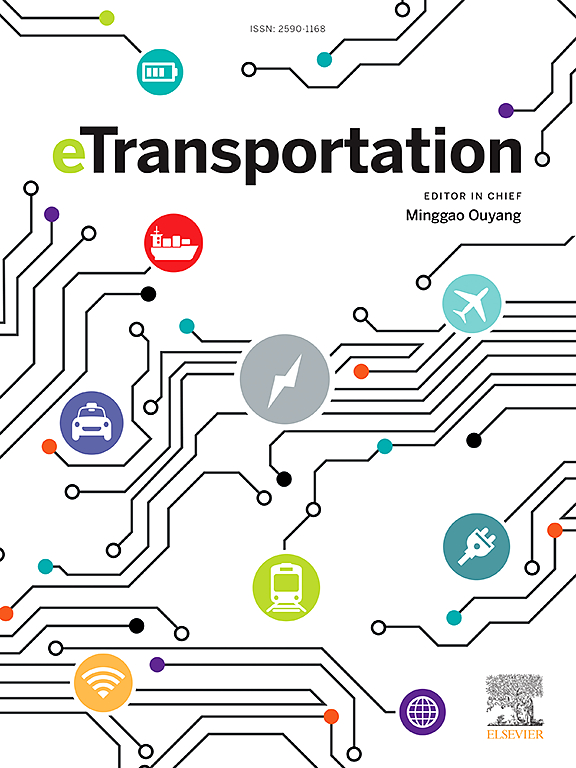超高电流密度下新型集成结构大尺寸质子交换膜燃料电池输运机理分析
IF 17
1区 工程技术
Q1 ENERGY & FUELS
引用次数: 0
摘要
对于质子交换膜燃料电池来说,提高功率密度是至关重要的,设计新颖的结构来减小体积是一个至关重要的途径。金属泡沫为传统的流场提供了一个很有前途的替代品,以避免对气体扩散层的需要,尽管与电极的微观结构差异带来了困难,特别是在大型燃料电池中。本研究设计了金属镍泡沫与碳纳米纤维膜(CNFF)相结合的一体化燃料电池结构,将单体电池厚度从1.275 mm减小到0.885 mm。CNFF促进了气体从金属泡沫到催化剂层的传输。建立了三维加一维的数值模型来阐明其内部机理。在1cm2的燃料电池中,更薄的CNFF会导致膜电极组件(MEA)脱水,而更高的孔隙率会阻碍散热。当放大到300cm2时,与传统的平行通道肋燃料电池相比,由于离子欧姆损失的增加,集成燃料电池在低电流和中电流密度下表现出较差的性能。然而,在高电流密度下,由于浓度损失减少,输出电压在4.1 A cm−2时从0.552 V上升到0.593 V,超过了传统的输出电压。此外,温度和相对湿度是影响膜含水量与传输阻力平衡的关键参数。该研究有助于提高体积功率密度的集成燃料电池的设计,为其大规模实施提供了有价值的见解。本文章由计算机程序翻译,如有差异,请以英文原文为准。

Transport mechanisms analysis of large-size proton exchange membrane fuel cells with novel integrated structure under ultra-high current densities
For proton exchange membrane fuel cells, augmenting power density is of utmost importance and designing novel structures to diminish volume represents a vital approach. Metal foam presents a promising substitute for conventional flow fields to obviate the need for gas diffusion layers, though the microstructural discrepancies with electrodes pose difficulties, especially in large-scale fuel cells. In this research, an integrated fuel cell structure combining nickel metal foam and a carbon nano fiber film (CNFF) is designed, trimming the single cell thickness from 1.275 mm to 0.885 mm. The CNFF facilitates the gas transport from metal foam to catalyst layers. A three-dimensional plus one-dimensional numerical model is constructed to elucidate the internal mechanisms. In a 1 cm2 fuel cell, a thinner CNFF leads to membrane electrode assembly (MEA) dehydration and higher porosity hinders heat dissipation. When scaling up to 300 cm2 and contrasting with a conventional parallel channel-rib fuel cell, the integrated fuel cell shows inferior performance at low and medium current densities due to elevated ionic ohmic loss. However, it surpasses the conventional one at high current densities, with the output voltage rising from 0.552 V to 0.593 V at 4.1 A cm−2 due to diminished concentration loss. Additionally, temperature and relative humidity are pivotal parameters influencing the equilibrium between membrane water content and transport resistance. This research contributes to the design of integrated fuel cells with enhanced volume power density, providing valuable insights for their large-scale implementation.
求助全文
通过发布文献求助,成功后即可免费获取论文全文。
去求助
来源期刊

Etransportation
Engineering-Automotive Engineering
CiteScore
19.80
自引率
12.60%
发文量
57
审稿时长
39 days
期刊介绍:
eTransportation is a scholarly journal that aims to advance knowledge in the field of electric transportation. It focuses on all modes of transportation that utilize electricity as their primary source of energy, including electric vehicles, trains, ships, and aircraft. The journal covers all stages of research, development, and testing of new technologies, systems, and devices related to electrical transportation.
The journal welcomes the use of simulation and analysis tools at the system, transport, or device level. Its primary emphasis is on the study of the electrical and electronic aspects of transportation systems. However, it also considers research on mechanical parts or subsystems of vehicles if there is a clear interaction with electrical or electronic equipment.
Please note that this journal excludes other aspects such as sociological, political, regulatory, or environmental factors from its scope.
 求助内容:
求助内容: 应助结果提醒方式:
应助结果提醒方式:


